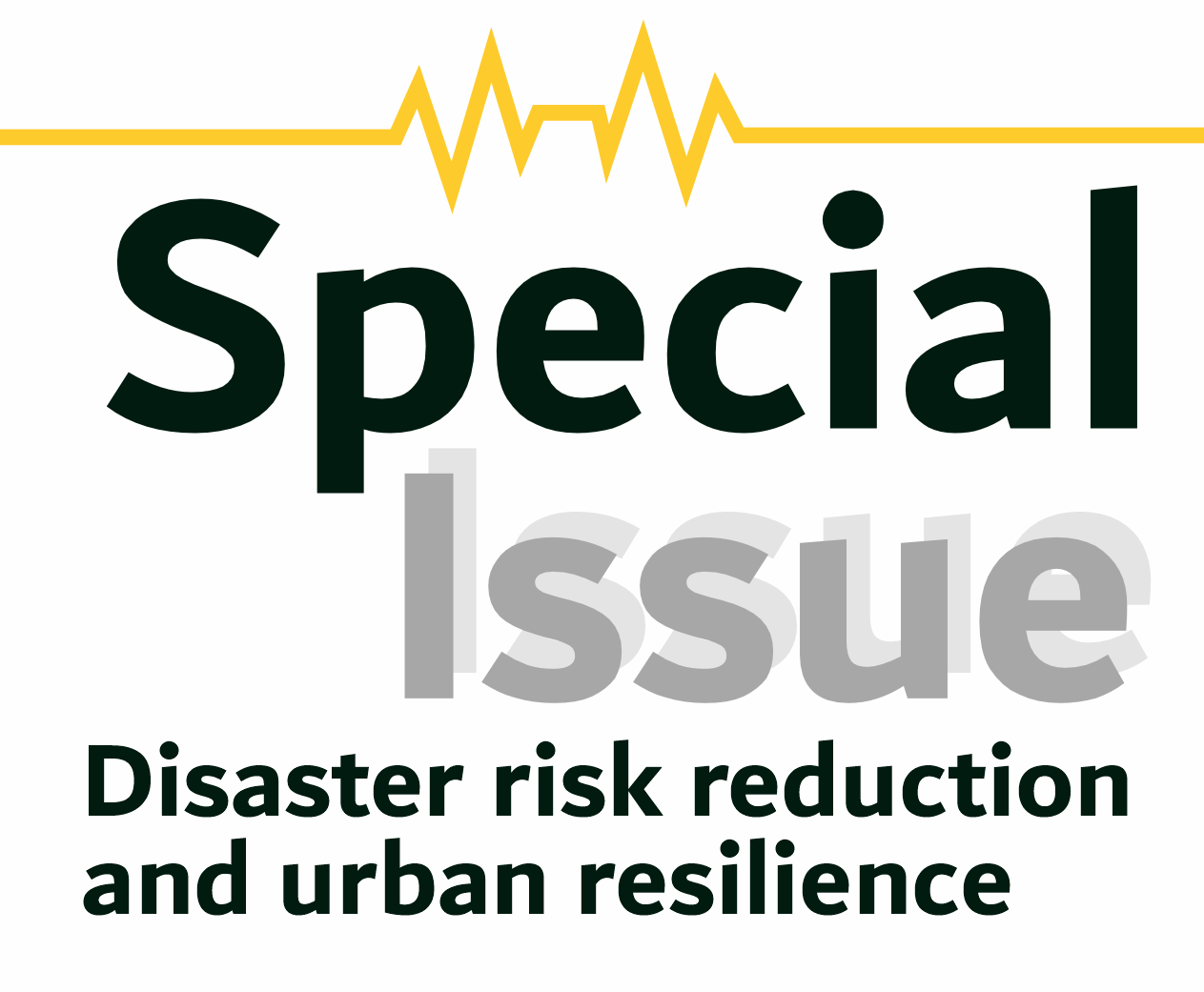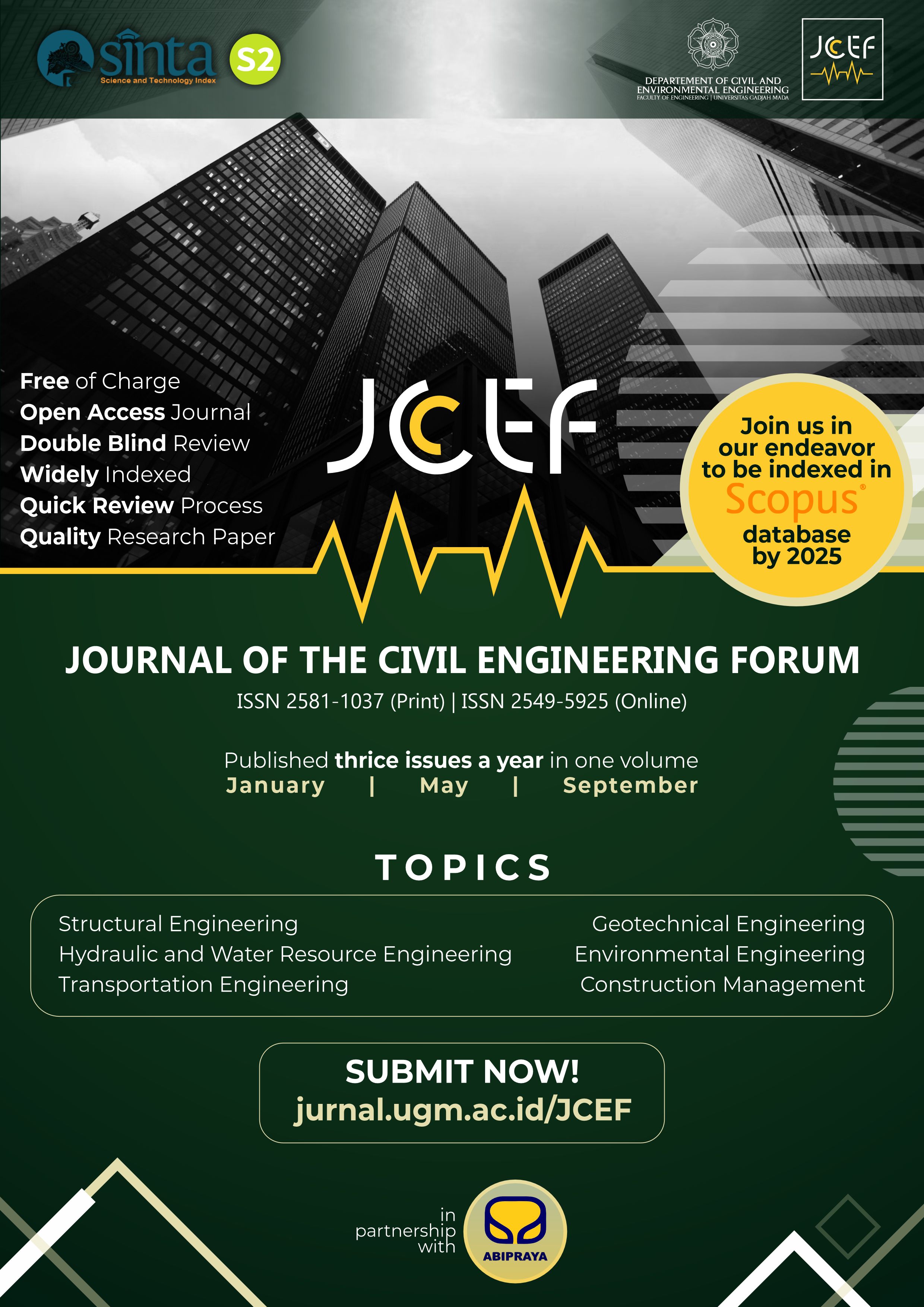Shear Strength and Durability Behaviors of Compacted Weathered Clay Shale Mixture Using Portland Cement
Abstract
The use of weathered clay shale often has the potential to cause geotechnical problems as an embankment material, especially slope failures. In order for weathered clay shale to be used as embankment material, the weathered clay shale must be mixed with other materials. An example of a widely used mix is a mix with a Portland cement (PC). In general, this mixture will increase the shear strength of the embankment material. In addition to shear strength, it is very important to investigate whether the material mixture is susceptible to durability. Therefore, this study aims to evaluate the shear strength and durability behaviors of weathered clay shale mixture, using PC. The percentage of this cement was varied and did not exceed 20%, with the mixing material also compacted based on Proctor Standard procedure. This test included the determination of shear strength and durability index at the smaller and larger (dry and wet sides) than optimum moisture content (OMC). Shear strength and durability index were determined by Triaxial and slake durability index tests, respectively. The results showed that the weathered clay mixture with 10% PC and 8% larger OMC led to an increase in the normalized shear strength (∆σ/σ) and durability index at approximately 300% and 24%, respectively, compared to the original clay shale. This indicated that the optimum shear strength and durability of this shale mixture were highly observed at 10% PC and 8% larger OMC (wet side). This verified also although the durability index increased by 97% with the addition of 20% PC, whose utilization was found to be unrealistic
References
Alatas, I. M. (2006), Stabilisasi lempung expansive dengan metoda scmt, in ‘Perkembangan Terkini Pemanfaatan Cement pada Rekayasa Geoteknik’, ISTN-Indocement-HATTI, Manhattan Hotel, Jakarta.
Alatas, I. M. (2016), ‘Kesan luluhawa terhadap kekuatan ricih syal lempung dalam penentuan parameter kestabilan cerun’.
Alatas, I. M. (2020), Argillaceous rock slope reinforcement due to failure in cariu west java, Technical report, PT. LTS Geoinves, Jakarta.
Alatas, I. M., Kamaruddin, S. A., Nazir, R., Irsyam, M. and Himawan, A. (2015), ‘Shear strength degradation of semarang bawen clay shale due to weathering process’, Jurnal Teknologi 77(11).
Alonso, E. and Pineda, J. (2006), ‘Weathering and degradation of shales: experimental observations and models of degradation meteorización y degradación de rocas arcillosas: observaciones experimentales y modelos de degradación’.
Castellanza, R. and Nova, R. (2004), ‘Oedometric tests on artificially weathered carbonatic soft rocks’, Journal of Geotechnical and Geoenvironmental Engineering 130(7), 728–739.
Ciantia, M. and Hueckel, T. (2013), ‘Weathering of submerged stressed calcarenites: chemo-mechanical coupling mechanisms’, Géotechnique 63(9), 768–785.
Erguler, Z. A. and Shakoor, A. (2009), ‘Quantification of fragment size distribution of clay-bearing rocks after slake durability testing’, Environmental & Engineering Geoscience 15(2), 81–89.
Himawan, A. (2011), Kajian geoteknik dan usulan teknis kemiringan lereng galian main road sta 22+375 – 22+840, Technical report, PT. Wijaya Karya, Jakarta.
Nazir, R., Alatas, I. M., Kamaruddin, S. A. and Irsyam, M. (2016), ‘Effect of weathering on disintegration and shear strength reduction of clay shale’, Jurnal Teknologi 78(7-3).
Nicholson, P. G. (2014), Soil improvement and ground modification methods, Butterworth-Heinemann.
Purnomo, E. A. (2020), ‘Prilaku tanah clay shale yang sudah lapuk distabilisasi dengan semen (studi kasus: Caly shale cariu, jonggol)’, Undergraduate Thesis.
Redyananda, A. (2021), ‘Pengaruh semen portland terhadap ketahanan tanah clay shale yang telah mengalami pelapukan’, Master Thesis.
Sadisun, I. A., Bandono, B., Shimada, H., Ichinose, M. and Matsui, K. (2010), ‘Physical disintegration characterization of mudrocks subjected to slaking exposure and immersion tests’, Indonesian Journal on Geoscience 5(4), 219–225.
Shakoor, A. and Gautam, T. (2011), Assessing the slaking behavior of clay bearing rock, in ‘10th Annual Technical Forum Geo-hazards Impacting Transportation in the Appalachian Region’, Ken State University, Columbus, Ohio. 178
Wawan, K. et al. (2019), Re-weathering of stabilized clay shale with portland cement behavior, in ‘MATEC Web of Conferences’, Vol. 276, EDP Sciences, p. 05009.
Copyright (c) 2022 The Author(s)

This work is licensed under a Creative Commons Attribution-ShareAlike 4.0 International License.
Copyright is granted to authors for the purpose of providing protection for articles written to describe experiments and their results. JCEF will protect and defend the work and reputation of the author and are also willing to address any allegations of violation, plagiarism, fraud, etc. against articles written and published by JCEF. JCEF is published under the terms of the Creative Commons Attribution-ShareAlike 4.0 International License (CC BY-SA 4.0). The author holds the copyright and assigns the journal rights to the first publication (online and print) of the work simultaneously.





